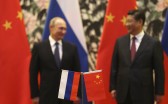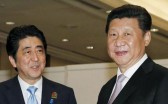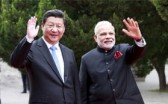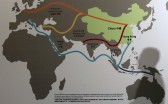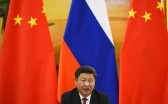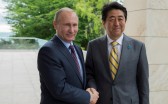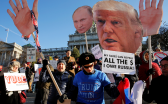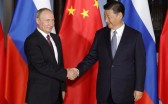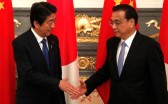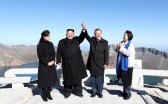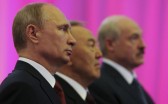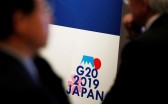Chinese and Russian leaders regularly declare that their countries’ bilateral relationship is at its highest level in history. The two countries share similar views on a range of international issues, and though they disavow any intention to form an alliance, they frequently proclaim their desire to oppose “hegemonism” and to build a multipolar world. In recent years, they have struck important deals in energy and arms sales while setting ambitious goals for expanding economic cooperation.
Despite these signs of warming relations, ample grounds exist for skepticism about their scope and potential for development. Historical memory and contemporary reality hint that China-Russia relations might remain strictly limited or even turn sour. The historical record, which includes three short-lived alliances in 1896, 1945, and 1950, leaves a legacy of mistrust that has not entirely disappeared. At present, the growing power imbalance in China’s favor also calls into question the basis for a close partnership.
It is possible, therefore, to envision a number of negative scenarios for China-Russia relations in the coming years. Leaving aside the alarmist visions that some Russian writers have advanced, including the possibility of a Chinese invasion of the Russian Far East and Siberia in attempt to seize territory and resources, I present a more realistic scenario in which China-Russia relations may lose momentum at the bilateral, regional, and global levels.
Bilateral Economic Ties: the Weak Link
In this negative scenario, problems begin at the bilateral level. More specifically, they originate from the weak link in China-Russia relations, namely economic cooperation. Bilateral economic relations, including trade volumes and financial flows, have long been much weaker than either country’s economic ties to Western countries. Russia’s pivot to the East, largely based on high hopes for strengthening economic cooperation with China, has largely failed thus far. Bilateral trade volumes reached $95 billion in 2014 but fell to $68 billion in 2015, largely because of the sharp fall in world energy prices. Chinese investment has failed to compensate Russia for losses from sanctions that the West imposed in response to the Ukraine crisis.
These trends could continue. In this negative scenario, bilateral trade volumes remain stagnant, falling well short of the two countries’ goal of $200 billion by 2020. Chinese investment fails to increase substantially, because of the lack of attractive investment opportunities in Russia and China’s reluctance to harm its economic relations with the United States. China-Russia scientific and technical cooperation remains limited, depriving Russia of the capital and technology required for its modernization. In short, China fails over the long run to serve as a full substitute for Russia’s dwindling economic ties with the West.
The negative trends could spill over into the two most important areas of bilateral economic relations, namely energy and military-technical cooperation. In energy relations, progress on the Power of Siberia gas pipeline, the product of a landmark $400 billion contract signed in May 2014, is slow. The two sides miss the 2018 target date for the pipeline’s opening, which experiences a delay of several years, perhaps into the middle of the next decade. Negotiations on Power of Siberia-2, a second gas pipeline that would follow a western route, break down entirely. Chinese investment in Russia’s upstream sector remains confined to a few select projects, much to China’s frustration.
In military-technical cooperation, two recent deals—China’s purchase of the S-400 air defense system and 24 Su-35 fighter jets from Russia—are exceptions to a long-term downward trend in Russian arms sales to China. Following the delivery of these systems, and possibly four Lada-class submarines, China’s increasingly capable indigenous military-industrial complex reduces the country’s need for future purchases from Russia. Their pledges to increase cooperation in research and development in the defense sector remain largely symbolic and fail to yield significant results for the most important weapons systems. In addition to continued concerns about China’s appropriation of Russian intellectual property, the two countries increasingly compete in arms export markets. In some cases, as in Russian sales to Vietnam and Indonesia, this competition heightens geopolitical tensions as well.
The Regional Level: Competing Visions
Problems in bilateral relations eventually extend to the regional level, especially in Central Asia but also in the Asia-Pacific. Russia traditionally regards Central Asia as its backyard, but China has made rapid inroads in the region. Therefore, a potential clash of interests poses a threat to the overall bilateral relationship. China’s proposed Silk Road Economic Belt (SREB) caused concern in Russia initially, but the two countries have sought to reach an understanding. In May 2015, they agreed to link the SREB with the Russia-led Eurasian Economic Union. Experts in both countries are developing proposals for cooperation in a variety of spheres, especially in transportation and infrastructure.
In a negative scenario, efforts to link the two projects would fall flat. In a fateful decision, China may choose a southern route for its new high-speed rail line to Europe rather than a northern route through Russia. Taking advantage of Iran’s opening following the removal of international sanctions, China builds a line that passes south of the Caspian Sea through Iran and Turkey. Russia may hope that China’s high-speed line would pass through Russian territory, but the southern route is shorter. China concludes, moreover, that it would not be economically feasible, at least for now, to build both routes. To its dismay, Russia then witnesses that the main thrust of the SREB is passing through other regions, and not Russia. In addition, China begins to marginalize Russia by working bilaterally with countries in Central Asia, frustrated by the failure to make progress on economic cooperation within the framework of the Shanghai Cooperation Organization (SCO).
In the wake of these disappointments, Russia still hopes that it can salvage its relations with China in Central Asia through an agreed division of labor. In this arrangement, China acts as the engine of regional growth, while Russia retains primary responsibility for regional security. China initially agrees but eventually concludes that it must increase its own security role in order to protect its growing investments in the region. Increasingly frequent consultations between the People’s Liberation Army and Central Asian militaries arouse Russia’s concern. China refrains from establishing military bases in the region, but Russia fears that China eventually will take this step as well.
China and Russia also experience tension in their relations in the Asia-Pacific. Russia’s position in the region remains weak because of its continued failure to develop Siberia and the Russian Far East. Cross-border cooperation between these sub-regions and China’s Northeast, including proposed infrastructural linkage, remains stalled, partly because of Russia’s own concerns about economic dependence on China. Frustrated by its inability to harness China’s economic power for the development of its eastern regions, and increasingly concerned about China’s growing power, Russia seeks to activate multilateral diplomacy in the Asia-Pacific. Russia’s continued cooperation with Vietnam in arms sales and energy provokes China. Its continued close relations with India and increasing outreach to Japan, including the prospect of settling the Kuril Islands dispute, also add to China’s mistrust of Russia’s intentions.
The Global Level: Common Interests for Now
Even if the scenarios outlined above were to occur, in whole or in part, common views at the global level still might serve as the basis for a close China-Russia partnership. Closer economic ties may strengthen the foundation of their relationship, but they may not be necessary to ensure continued cooperation at the global level. At present, within the US-China-Russia triangle, China and Russia boast the strongest bilateral relationship in political terms.
More than any other event, the rise of a strongly nationalistic government in China could trigger a big change at the global level. This could motivate Russian leaders to pivot toward the West in order to counter the possible long-term threat from China. In this scenario, Russia resolves many of its differences with the West and possibly even enters a nascent, informal balancing coalition against China. Russia and the West reach an agreement to cooperate on missile defense, undermining China’s desire to work with Russia to oppose US hegemony. Russia may even join the United States in urging China to participate in the next round of talks on nuclear arms reduction. These events could undermine one of the fundamental objectives of the China-Russia strategic partnership, namely each country’s desire to ensure that the other maintains strategic distance from the United States.
Conclusion
In this negative scenario, problems at the bilateral level are the most likely to appear in the near term, whereas regional clashes of interest might develop over the medium term. A fundamental realignment at the global level, which China and Russia currently seek to avoid, would occur only over the long term. Given the wild swings that have occurred throughout the history of China-Russia relations, however, analysts cannot entirely rule out such an outcome.

